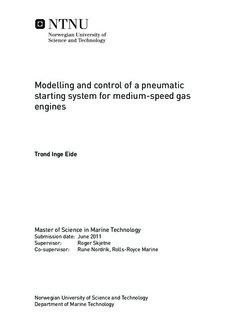| dc.description.abstract | This thesis investigates starting systems for marine gas engines. Large combustion engines are usually started by means of pneumatic starting arrangements. The most common ways of starting a combustion engine with compressed air, are to use a pneumatic engine coupled to the engine flywheel, or to inject the air directly into the engine cylinders through a valve in the cylinder air. Pneumatic starting engines are prefered for gas engines with a prechamber.
The main challenge related to starting of gas fueled engines, is to avoid ignitable consentrations of gas outside the engine cylinders. Gas engines have an increased emission of unburned gas during starting and stoping. If the consentration of unburnes gases in the exhaust system of the combustion engine gets to large, the gas can be ignited by hot spots or sparks. In addition, we are conserned with the air consume of the starting system. The capacity of the starting system is regulated by class rules. To reduce the cost of the system, we want to reduce the air consume per start.
In this thesis, mathematical models of the combustion engine and the starting system are developed and validated against experimental results from starting tests of the real system. The objective is to give means for investigating, by using computer simulations, if the existing starting system can be improved. The validation showed that the model captures the main dynamics of the system.
To avoid large concentrations of unburned fuel mixtures in the exhaust system, the starting system is used to purge the engine before allowing fuel to the engine cylinders. In practice, the combustion engine is operated as an air pump which pumps air from the charge air system, via the engine cylinders, and to the exhaust system. A way of improving the safety of the starting sequence by purging the engine for a fixed number of rotations, is proposed. This method gives stricter control of the purged volume, but increases air consume.
To reduce air consume, it is advantegous to keep the engine speed low during purging. Three concept for reducing the engine speed are explored. The simulations indicate that the best performance is obtained by using an electrically controlled pressure control valve, in combination with a Proportional-Integral- Derivative feedback controller, to regulate the engine speed. This concept is extensively tested by means of simulations, to evaluate its robustness with regards to system uncertainties and different plant dimensions. | nb_NO |
